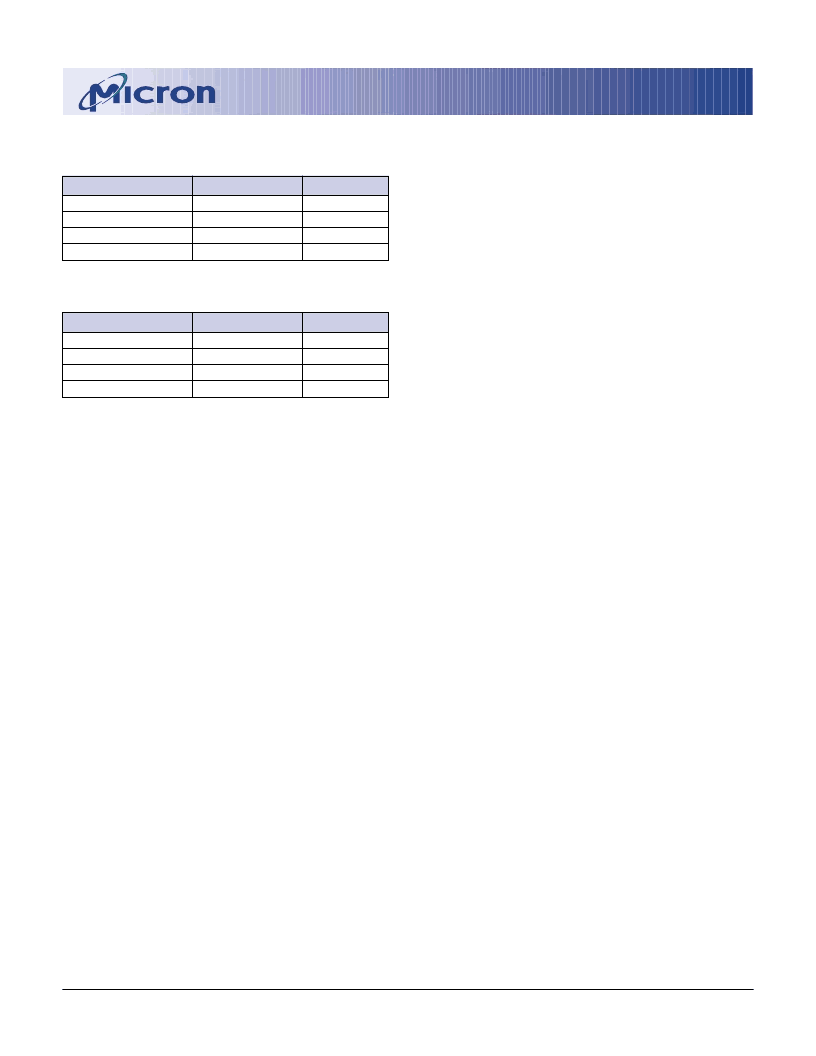- 您現(xiàn)在的位置:買賣IC網(wǎng) > PDF目錄384759 > MT4LDT464HS (Micron Technology, Inc.) SMALL-OUTLINE DRAM MODULE PDF資料下載
參數(shù)資料
| 型號: | MT4LDT464HS |
| 廠商: | Micron Technology, Inc. |
| 英文描述: | SMALL-OUTLINE DRAM MODULE |
| 中文描述: | 小外形DRAM模塊 |
| 文件頁數(shù): | 2/32頁 |
| 文件大?。?/td> | 625K |
| 代理商: | MT4LDT464HS |
第1頁當(dāng)前第2頁第3頁第4頁第5頁第6頁第7頁第8頁第9頁第10頁第11頁第12頁第13頁第14頁第15頁第16頁第17頁第18頁第19頁第20頁第21頁第22頁第23頁第24頁第25頁第26頁第27頁第28頁第29頁第30頁第31頁第32頁

4, 8 Meg x 64 DRAM SODIMMs
DM83.p65 – Rev. 2/99
Micron Technology, Inc., reserves the right to change products or specifications without notice.
1999, Micron Technology, Inc.
2
4, 8 MEG x 64
DRAM SODIMMs
CAS#. Additional columns may be accessed by provid-
ing valid column addresses, strobing CAS# and hold-
ing RAS# LOW, thus executing faster memory cycles.
Returning RAS# HIGH terminates the FAST-PAGE-
MODE operation.
EDO PAGE MODE
EDO PAGE MODE, designated by the “X” option,
is an accelerated FAST-PAGE-MODE cycle. The pri-
mary advantage of EDO is the availability of data-out
even after CAS# goes back HIGH. EDO provides for
CAS# precharge time (
t
CP) to occur without the out-
put data going invalid. This elimination of CAS#
output control provides for pipelined READs.
FAST-PAGE-MODE modules have traditionally
turned the output buffers off (High-Z) with the rising
edge of CAS#. EDO operates as any DRAM READ or
FAST-PAGE-MODE READ, except data will be held
valid after CAS# goes HIGH, as long as RAS# and OE#
are held LOW and WE# is held HIGH. (Refer to the 8
Meg x 8 EDO DRAM data sheet for additional infor-
mation on EDO functionality.)
REFRESH
Memory cell data is retained in its correct state by
maintaining power and executing any RAS# cycle
(READ, WRITE) or RAS# refresh cycle (RAS#-ONLY,
CBR or HIDDEN) so that all combinations of RAS#
addresses are executed at least every
t
REF, regardless of
sequence. The CBR REFRESH cycle will invoke the
internal refresh counter for automatic RAS# address-
ing.
An optional self refresh mode is also available on
the “S” version. The “S” option allows the user the
choice of a fully static, low-power data retention mode
or a dynamic refresh mode at the extended refresh
period of 128ms, or 125μs per row when using distrib-
uted CBR REFESH. The optional self refresh feature is
initiated by performing a CBR REFRESH cycle and
holding RAS# LOW for the specified
t
RASS.
The self refresh mode is terminated by driving RAS#
HIGH for a minimum time of
t
RPS. This delay allows
for the completion of any internal refresh cycles that
may be in process at the time of the RAS# LOW-to-
HIGH transition. If the DRAM controller uses a distrib-
uted refresh sequence, a burst refresh is not required
upon exiting self refresh. However, if the DRAM con-
troller utilizes a RAS#-ONLY or burst refresh sequence,
all 1,240 rows must be refreshed within the average
internal refresh rate, prior to the resumption of normal
operation.
PART NUMBERS
FPM Operating Mode
PART NUMBER
MT4LDT464HG-x
MT4LDT464HG-x S
MT8LDT864HG-x
MT8LDT864HG-x S
x = speed
CONFIGURATION
4 Meg x 64
4 Meg x 64
8 Meg x 64
8 Meg x 64
REFRESH
Standard
Self
Standard
Self
EDO Operating Mode
PART NUMBER
MT4LDT464HG-x X
MT4LDT464HG-x XS
MT8LDT864HG-x X
MT8LDT864HG-x XS
x = speed
CONFIGURATION
4 Meg x 64
4 Meg x 64
8 Meg x 64
8 Meg x 64
REFRESH
Standard
Self
Standard
Self
GENERAL DESCRIPTION
The MT4LDT464H (X)(S) and MT8LDT864H (X)(S)
are randomly accessed 32MB and 64MB memories
organized in a small-outline, x64 configuration. They
are specially processed to operate from 3V to 3.6V for
low-voltage memory systems.
During READ or WRITE cycles, each location is
uniquely addressed via the address bits. The row ad-
dress is latched by the RAS# signal, then the column
address is latched by the CAS# signal.
READ and WRITE cycles are selected with the WE#
input. A logic HIGH on WE# dictates read mode, while
a logic LOW on WE# dictates write mode. During a
WRITE cycle, data-in (D) is latched by the falling edge
of WE# or CAS#, whichever occurs last. An EARLY
WRITE occurs when WE# is taken LOW prior to CAS#
falling. A LATE WRITE or READ-MODIFY-WRITE oc-
curs when WE# falls after CAS# is taken LOW. During
EARLY WRITE cycles, the data outputs (Q) will remain
High-Z, regardless of the state of OE#. During LATE
WRITE or READ-MODIFY-WRITE cycles, OE# must be
taken HIGH to disable the data outputs prior to apply-
ing input data. If a LATE WRITE or READ-MODIFY-
WRITE is attempted while keeping OE# LOW, no
WRITE will occur, and the data outputs will drive read
data from the access location.
FAST PAGE MODE
FAST-PAGE-MODE operations allow faster data
operations (READ or WRITE) within a row-address-
defined page boundary. The FAST-PAGE-MODE cycle
is always initiated with a row address strobed in by
RAS#, followed by a column address strobed in by
相關(guān)PDF資料 |
PDF描述 |
|---|---|
| MT4LDT464HX | SMALL-OUTLINE DRAM MODULE |
| MT8LSDT864 | SMALL-OUTLINE SDRAM MODULE |
| MT4LSDT464H | SMALL-OUTLINE SDRAM MODULE |
| MT4LSDT464L | SMALL-OUTLINE SDRAM MODULE |
| MT4LSDT464LH | SMALL-OUTLINE SDRAM MODULE |
相關(guān)代理商/技術(shù)參數(shù) |
參數(shù)描述 |
|---|---|
| MT4LDT464HX | 制造商:MICRON 制造商全稱:Micron Technology 功能描述:SMALL-OUTLINE DRAM MODULE |
| MT4LDT464HXS | 制造商:MICRON 制造商全稱:Micron Technology 功能描述:SMALL-OUTLINE DRAM MODULE |
| MT4LDT832HG-5X | 制造商:MICRON 制造商全稱:Micron Technology 功能描述:SMALL-OUTLINE DRAM MODULE |
| MT4LDT832HG-5XS | 制造商:MICRON 制造商全稱:Micron Technology 功能描述:SMALL-OUTLINE DRAM MODULE |
| MT4LDT832HG-6X | 制造商:MICRON 制造商全稱:Micron Technology 功能描述:SMALL-OUTLINE DRAM MODULE |
發(fā)布緊急采購,3分鐘左右您將得到回復(fù)。